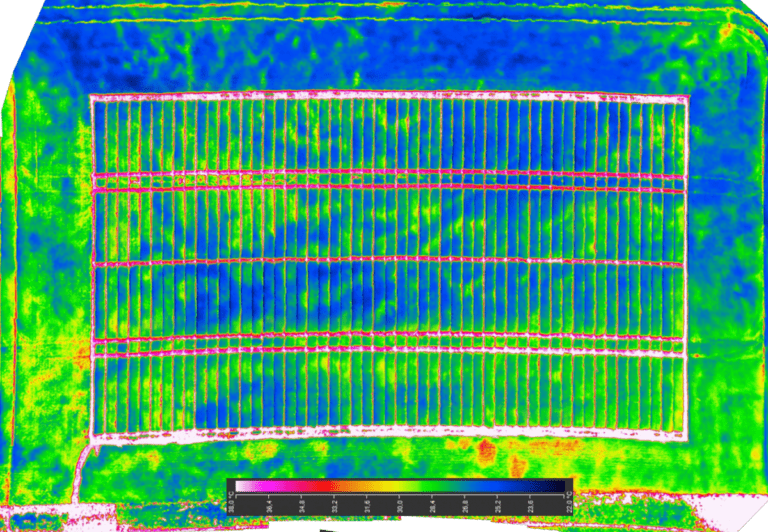Detection of water stress cereals crops with thermal camera UAV
The availability of water throughout a crop’s growth cycle is a primary factor affecting the yield, quality, and profitability of agricultural production. During droughts, plants become stressed and close their stomata, and the vital transpiration process that cools vegetation slows. In areas experiencing climatic variability, monitoring plant temperatures is key to ensuring crop health.
The rapid detection and quantification of elements of varietal resistance to stress, as well as the quick detection and quantification of the elements of surface variability for weak moisture, are essential for the management of field crops. This data can be used for the selection and delimitation of species and varieties of crops within agricultural enterprises. They can also be used for precision farming, the clarification of moisture needs in irrigation, and a variety of other applications.


Water stress?
To scan the thermal condition of experimental varieties, we used the Workswell WIRIS thermal camera, supported by the DJI S1000 UAV platform. The flight was pre-programmed via UGCS Ground Station. Then, the data was processed in the Pix4D program and analyzed by Workswell CorePlayer and Workswell Thermoformat software.
The figure on the left shows the experimental land and the experimental areas (the latter in detail) (1500 m2), with tests aimed at the lines of winter wheat with differently sized root systems, each of which affects drought tolerance. Stress is induced by shading and the optimal water content is maintained by dripping irrigation.
How does it work?
Thermal cameras can be an effective tool for detecting water stress in cereal crops. Water stress in crops occurs when there is a deficiency of water supply, either due to inadequate irrigation or natural factors such as drought. This can negatively impact crop growth, yield, and overall health. Thermal cameras, also known as infrared cameras, can detect temperature differences in crops, which can be indicative of water stress.
Here’s how a thermal camera can be used for detecting water stress in cereal crops:
Thermal imaging: A thermal camera can capture the infrared radiation emitted by plants, which is influenced by their temperature. When crops are under water stress, they tend to have higher temperatures compared to well-hydrated crops. This is because transpiration, the process by which plants lose water through their leaves, is reduced under water stress, leading to higher leaf temperatures.
Temperature analysis: The thermal images captured by the camera can be analyzed using specialized software that can generate temperature maps or thermal indices. These maps can help identify areas of the crop that are experiencing higher temperatures, indicating potential water stress. For example, the Crop Water Stress Index (CWSI) is a commonly used thermal index that compares the temperature of a plant to the temperature of a well-watered reference plant. Higher CWSI values indicate higher water stress.
Comparison with baseline: The thermal images can be compared to baseline data of well-hydrated crops to identify temperature anomalies. A healthy, well-hydrated crop would generally have relatively uniform temperatures across the field, while a water-stressed crop would exhibit higher temperatures in specific areas or patches.
Ground truth validation: Thermal imaging findings can be validated with ground truth data, such as soil moisture measurements, plant physiological measurements, and visual assessments of crop health. This can help confirm the presence of water stress in the crop and provide more accurate results.
Timely monitoring: Thermal cameras can be used for regular monitoring of crops throughout the growing season to track changes in crop temperature and detect water stress early. This can allow farmers to take corrective actions, such as adjusting irrigation schedules, to mitigate water stress and minimize crop losses.
It’s important to note that while thermal cameras can be a useful tool for detecting water stress in cereal crops, they should be used in conjunction with other agronomic practices and data sources for accurate and reliable results. Farmers and agronomists should also be familiar with the specific crop’s physiological characteristics, growth stages, and environmental conditions to correctly interpret thermal imaging data and make informed management decisions.
Our data analysis and validation in semi-operating conditions suggests a new possibility for the quantitative and qualitative evaluation of abiotic stress induced in cereals due to lack of moisture.
For further applications, we foresee the development of models based on exact ground measurements. In combination with such ground measurements, data scanned from the air shall be easily, quickly and reliably interpreted, even when it is based on the index of water stress in plants (CWSI) that is specific to certain varieties in the area of cultivation.



